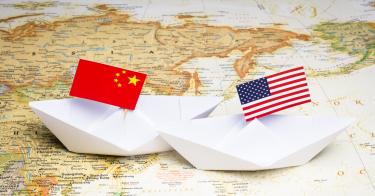The Navy’s advantage over our biggest military adversary, China, is dwindling rapidly. Yet some House leaders overseeing national defense don’t seem too worried about it.
Earlier this month, the chairs of the House Appropriations Defense Subcommittee and the House Armed Services Committee followed up with a misleading, albeit reassuring, qualitative comparison of the two navies with a comforting assurance that our allies will help fight our wars to safeguard our interests. Spoiler alert: They never have, nor will they ever.
On May 11, Rep. Betty McCollum, chair of the House Appropriations defense subcommittee, said, “the Chinese may have 500 ships, but 230 of those are small support vessels that do not have a qualitative edge over U.S. combat ships … the United States can count on allies … Japan, with 154 ships, South Korea, with 160 ships, and Australia, with 43 ships.”
That same day, Rep. Adam Smith, chair of the House Armed Services Committee, said, “But we—all we see from the China—China, well, they’ve got this number. Well, how capable are their ships? How many ships does China have deployed all around the world in any given moment? That’s a very low number from what I understand. And—and the capability of those ships are not as great either.”
>>> The Navy’s Latest Shipbuilding Plan May Sink America’s Pacific Ambitions
The claim that the U.S. Navy’s 298 warships—when augmented by allies Japan, South Korea and Australia—outstrip the Chinese navy’s certainly supports the administration’s desire to cut the Navy down to 280 warships by 2027. It is, however, completely out of step with reality.
There are two things to consider: quality in numbers and expectations of how allies would support U.S. interests.
First, consider just China’s most lethal and modern naval combatants. That number is 148, based on the Defense Department’s annual China report. But, add in the smaller warships you’d have to defend against and—at a minimum—track to avoid them getting a lucky shot in, and the number jumps to 285. This does not include China’s ballistic missile submarines or their 57 amphibious warships or 223 Coast Guard cutters (many repurposed navy warships)—making the total 571 in 2021 (higher now, given the speed at which China is building warships).
Now, applying that same metric to the U.S. Navy, you get a number of active lethal warships of 167—no littoral combat ships and only nine of the largest amphibious warships (America and Wasp class), to be consistent.
While we have treaty obligations to NATO to consider, with respect to allies in Asia, there are no obligations for them to come to our (or Taiwan’s) defense. So, expectations of Japan or South Korea joining us in a war with China, absent strong national interests of their own, is incredibly misplaced. And it is a dangerous assumption to make when determining the size of the Navy the U.S. needs: politics and national interests can change quickly, but shipbuilding takes years.
Peacetime competition in the South China Sea and a potential war over Taiwan are also driving debates today over the future of our Navy. However, in such scenarios, our allies have operational limitations.
Japan is near Taiwan and would, for political as well as operational reasons, focus its maritime forces in the East China Sea. Japan’s maritime self-defense forces, using the earlier metric, has 74 very capable warships to contribute, but with limited endurance for sustained distant operations and without strike capability.
South Korea faces an existential threat daily from North Korea, and its military focus will remain on deterring a war with the North. We will have to wait and see if newly inaugurated South Korean President Yoon Suk Yeol proposes a larger regional security role for his country.
Australia’s navy is too far away and too small to be decisive in a war with China but does play an increasingly impactful role in the peacetime competition with China over the South China Sea rules-based order. Aspirations of Australia deploying a nuclear submarine with the recent AUKUS initiative are welcome, but delivery is far from certain and too far in the future to affect today’s debates here about the size of the Navy.
>>> The Nuclear Sea-Launched Cruise Missile: Worth the Investment for Deterrence
That leaves the U.S. as the dominant maritime player in the South China Sea with Japan adding significantly in the East China Sea to meaningfully contest a Chinese naval war. That said, assuming allies will do America’s bidding in conflict—and especially in the peacetime competition with China—is fanciful.
Lastly, China’s air and missile threats are pushing the U.S. Navy to be more distributed and further from the fight. That drives up the need for more U.S. warships. And our nation’s inability to rebuild wartime losses even further emphasizes bigger numbers and the need to win any war with China< decisively and quickly—something increasingly unlikely as we let our ship numbers dwindle.
In this dangerous decade with China, allies do matter. They are our asymmetric advantage, but they are not a replacement for the Navy the nation needs. In fact, if the U.S. is without a relevant naval force, those same allies may very well seek security elsewhere.
This piece originally appeared in The Washington Times




